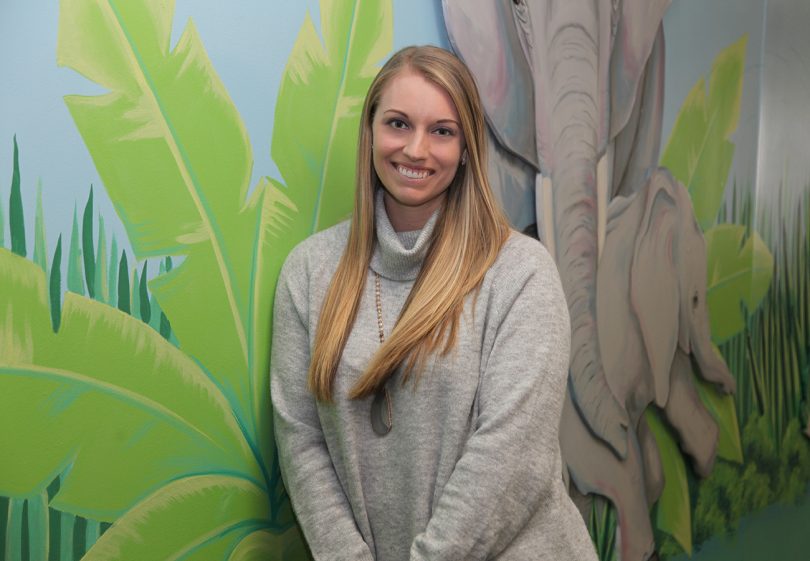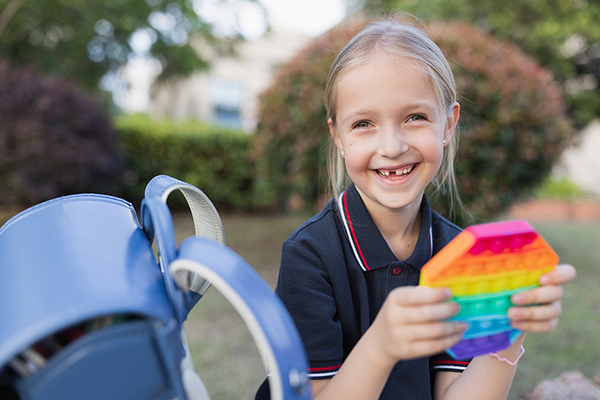4:45 a.m.: Good morning! Yes, I really do wake up this early, even though I don’t have children of my own yet—other than my three dogs. I work out after I wake up, because I know if I don’t do it in the morning, I won’t do it when I go home from work. Plus, my husband’s in the military and is getting up then anyway. So after a pre-workout smoothie of protein powder, almond milk, orange juice, fruit and some oats, it’s just me and my dog, Zoey, hanging out in the weight room in our garage. Then, I have another post-workout shake, and it’s time to get ready for work!
8 a.m.: The Children’s Hospital of Georgia has the only pediatric dietitians in this region, with Columbia, Savannah and Atlanta being the next closest sites. So we stay incredibly busy, seeing patients sometimes from up to five hours away. The great thing is that we’re free for any child to see! Every day is a little different for me, so here’s how my week breaks down:
Mondays
Most Mondays, I’m in clinic all day, working with children who may need to lose some weight (weight management), children who aren’t gaining weight (failure to thrive) as well as children with eating disorders. I also may see patients from the renal clinic since these kids need a special diet.
Weight management is what most people think of when they think about dietitians, and I do see these patients the most often. I like to always start by getting a good idea of what these kids are eating now. It’s easy to assume that they’re eating unhealthily, but I’ve learned that it’s best not to make assumptions and to ask patients give me all of that information.
What I really like to pick out is if they’re actually eating. Sometimes kids will skip breakfast and lunch if they don’t like what’s being offered at school. Then they come home starving, and their snack will be the size of two meals! All of that is terrible for the metabolism. So we’ll focus on regular meal patterns: breakfast, lunch, snack and dinner.
Portion sizes come next. I’ll use the U.S. Department of Agriculture’s Choose My Plate, which shows a plate. Half should be vegetables; one-quarter should be a healthy carb; and one-quarter should be meat. Then we discuss appropriate drinks. Water, of course, is the best, but sometimes, I’ll say it’s OK to drink some Crystal Light or diet soda for the flavor. However, I also explain that we don’t know the long-term consequences of these artificial sweeteners. I’ll also steer families away from sweet tea and even juice since both are full of sugar.
Most of these kids may not be exercising, so we talk about exercise goals too. Especially with teens, I want to direct everything to them because they’re old enough to make these choices. For younger kids, I’ll talk this over with parents.
But above all, I don’t put a lot of focus on the scale. Yes, weight is a measurement, but that is not the end all, be all. I want to really focus on making healthy lifestyle changes, so if a child is exercising everyday and eating really well, that’s our goal.
What we don’t want is for kids to go on crash diets where they lose a lot of weight, but can’t sustain that then put the weight back on. That just creates a negative association with food and eating and exercise, where it can feel like a punishment, instead of being nourishing and sustaining to our bodies. Healthy food can be fun and just as tasty!
In fact, I’ll get the whole family involved in picking out recipes to make at home every night of the week. A parent buys the ingredients on Sunday, then the whole family can cook together all week long—teens especially can help chop vegetables or peel potatoes, and younger kids can mix and stir. This also encourages families to eat together at home instead of eating out, which will always be healthier! And I think parents appreciate not having to do all the “brain work” of picking out what to eat every night.
Tuesdays
On alternate Tuesdays, I’ll see patients from the cystic fibrosis clinic and from the EOE clinic.
The biggest thing with CF patients is that many of these kids don’t want to eat because their lungs produce so much mucus, and they’re also swallowing a lot of it, which makes them feel full. Along with that, they need to also take several enzyme pills before every meal, which also fills them up. So we focus on putting together a high-calorie, high-protein diet, but in a healthful way. It’s about adding olive oil to pasta or tossing vegetables in canola oil or adding heavy cream to milk. Our goal is to help parents and kids as much as possible balance medical care with everyday life and try to make the challenges of a chronic disease easier.
Many people may have never heard of EOE, or eosinophilic esophagitis, which is essentially an allergic reaction to food, but it only shows up inside the body, not outside. Allergy testing doesn’t pick it up, but it does show up on endoscopy. Kids with EOE may go undiagnosed for years since they just think that they are supposed to get reflux when they eat, until the inflammation gets so bad that food literally gets stuck in their throat and has to be surgically removed.
The good news is that for 80 percent of these kids, symptoms go away once you remove the top eight allergy-inducing foods: milk, soy, eggs, wheat, fish, shellfish, peanuts and tree nuts. Then, we can slowly add foods back in one at a time, doing repeat endoscopies every two to three months, to pinpoint exactly which food is causing the problem.
But you can imagine that when you cut out these eight foods, it creates a diet that can be extremely difficult to follow. So my role at initial diagnosis is to help parents learn how to remove these foods from the diet, provide recipes and share tips on where to buy safe milk for example (coconut or pea protein milk are great—pea protein milk in particular tastes just like vanilla pudding!) or safe places to eat out.
Wednesdays
I’ll see patients from the CF clinic or ventilator clinic.
Thursdays
I’ll alternate once again, seeing EOE patients one week, then weight management and other patients the next week.
Fridays
This is usually another CF clinic day or a day to see various patients. Sometimes I’ll also catch up on charting for the week.
The Rest of My Days
So in between seeing patients, meetings or paperwork, I do focus on eating healthy myself throughout the day. Every Sunday, my husband and I work to prep meals for the week so that it’s easy to pack everything up for work every weeknight. So after my pre- and post-workout smoothie, my breakfast/midmorning snack comes at about 10 a.m., where I like to eat protein waffles—cottage cheese, eggs and oats all blended together and cooked on a waffle iron—topped with sugar-free syrup and peanut butter.
At 12:30 p.m., I usually have a quick lunch at my desk, which always includes a good vegetable with lean meat, like my fajita pasta—chicken with bell peppers, onions and other veggies tossed with whole grain pasta.
At 3:30 p.m., I’m usually done seeing patients and ready for charting, which I usually work on with a snack of carrots or baby cucumbers with hummus. Or even a salad: I don’t think a snack always needs to look like a snack.
After I leave work at 5, dinner is about 6-ish, and I love my slow cooker or Instant Pot—SkinnyTaste.com or Pinterest are great resources for recipes. One I love is Mississippi Pot Roast—pot roast cooked with four tablespoons of butter, brown gravy mix, ranch dressing mix and three or four pepperoncini, on low for eight hours in the slow cooker. I like to serve this with brown rice, green beans and carrots.
And that’s it! I just love my job—I think I’m just a kid at heart, which is why I get along so well with kids and click well too with teens. I’m at a good age right now—old enough to be a role model, but not too old to be unrelatable. It’s just fun—I don’t like coming in and doing the same thing every day. This job is good for me because it’s constantly changing, and I’m always given something new.




